I need to convert the instantaneous voltage output from my current transducer to a true RMS voltage output. Can anybody please suggest an IC that can perform this function.
1 Answers
Digikey has two pages of ICs that form the basis of a system to do this here
The examples below are RMS voltage to DC converters. Current to DC conversion requires an initial "simple" current to voltage conversion. Care needs to be taken re crest factors that the IC's will work over (over about 5:1 needs special care) and accuracy reduces with increasing crest factor. Input voltage range may be limited eg 5 to 1000 mV for AD737, less again for LTC1966. ie - while this sort of IC is useful the limitations need o be appreciated and the datasheet should be carefully examined.
Gargoyling
rms converter
as per here will produce a large number of references .
Just to open up the mental filters - you can use thermistors and "ordinary" opamps as the heart of an RMS converter as seen here.

And to carry this to extremes [tm] the LT1088 integrates two heaters and temperature driven diodes in an IC package and provides an RMS converter with a 3dB bandwidth of 300 MHz (!!!!), 50:1 crest factor (!!! again) but a still only modest 20:1 dynamic range.
See Linear Technology AN 22 - 1987!!! - A Monolithic IC for 100 MHz RMS-DC conversion.
You mau have trouble BUYING such an ICnowadays, but the ideas in the app note would allow you to buld a creditable one with "not too much work" [tm, yet again].
Yee Ha !!!

Cheap modern off the shelf entry level products:
As an example only - chosen on the basis of being in stock and chea[pest in 1 quantity - LTC1966 - datasheet here $5.88/1 in stock. Looks "useful. They say
Simple to Use, Requires One Capacitor
True RMS DC Conversion Using DS Technology
High Accuracy:
- 0.1% Gain Accuracy from 50Hz to 1kHz
- 0.25% Total Error from 50Hz to 1kHz
High Linearity - 0.02% Linearity allows Simple System Calibration
Low Supply Current - 155µA Typ, 170µA Max
Ultralow Shutdown Current - 0.1µA
Constant Bandwidth independent of Input Voltage - 800kHz –3dB, 6kHz ±1%
Flexible Supplies:
- 2.7V to 5.5V Single Supply
- Up to ±5.5V Dual Supply
Flexible Inputs: Differential or Single-Ended
Rail-to-Rail Common Mode Voltage Range
Up to 1VPEAK Differential Voltage
Flexible Output: Rail-to-Rail Output
Separate Output Reference Pin Allows Level Shifting
Wide Temperature Range: –55°C to 125°C
Small Size: Space Saving 8-Pin MSOP Packag e
For $8.24 /1 the AD737 datasheet here comes in a PDIP8 package, seems a t aquick skim to offer similar perormance but with some pros and cons. (Made for ADC interfacing, multimeter focus, with or without output buffer (lower offset voltage without), ...
=================================
Q&A
Q: What you suggsted above is a RMS to DC converter.
I need an IC to convert my instantaneous AC signal to its true RMS value. – george 36 mins ago
A: An "instantaneous" AC signal IS a DC level.
The RMS value of an AC signal over a period is a DC level over the same period.
What may be wanted is the RMS value of an AC signal NOW based on the signal for a prior period up until now.
The DC value of such a calculation may change at each calculation and so give an AC varying RMS value.
- 147,325
- 18
- 210
- 386
-
Thanx for your reply, but what you suggsted above is a RMS to DCconverter. I need an IC to convert my instantaneous AC signal to its true RMS value. – george Mar 06 '12 at 11:30
-
NO RUDENESS INTENDED HERE - read carefully. Your comment suggests a lack of understanding of the question. An "instantaneous" AC signal IS a DC level. The RMS value of an AC signal over a period is a DC level over the same period. Please explain in words what you expect to put in and get out. You will almost certainly find that you are asking for an impossible or "nonsense" answer or that what you want is the RMS value of an AC signal NOW based on the signal for a prior period up until now. The DC value may change at each calculation and so give an AC varying RMS value. – Russell McMahon Mar 06 '12 at 12:04
-
Russell you are right in the fact that I lack understanding of the question.I see that you are an expert in electrical engineering, so can you please enlighten me or suggest some reading material that will give me a clear picture. Here is my problem. I an designing a soft starter to start a 3 phase synchronous generator(machine) asynchronously and once it reach the synchronous speed bypass the soft starter and connect it to the grid.I am using a tyristor rig to function as my soft starter.Now, for my current limiting control circuit will measure the current of on one phase of the machine. – george Mar 06 '12 at 13:09
-
Using a reference current it will limit the current to a set value.To measure the current a Hall effect transducer (LTA 50PR) was used.The true RMS voltage output which gives 20mV/A was used as the output signal from the transducer.But due to some reason the rms value pin is not working. The transducer also has an instantaneous voltage output which gives a signal of 20mV/A. The current that i an measuring contains harmonics therefore i can't use a precision rectifier and a gain factor of .7071 to convert the instantaneous signal to RMS signal. – george Mar 06 '12 at 13:30
-
So i was suggested to use an IC that can convert an AC signal to its true RMS signal and a 2nd order low-pass filter to remove the 2nd harmonic caused by the rms action. Can you please suggest me a solution here. Your advice will be greatly appreciated. – george Mar 06 '12 at 13:30
-
Easy way to get RMS is to use instantaneous output and an RMS multimeter. Many available and easier and possible as cheap as making your own. I'd also seriously look at Google. Look at [some of these to start](http://www.google.co.nz/search?q=soft+starter+synchronous&hl=en&safe=off&prmd=imvns&source=lnms&tbm=isch&ei=RhFWT7mADqmViQeRl6zgCA&sa=X&oi=mode_link&ct=mode&cd=2&ved=0CBkQ_AUoAQ&biw=1745&bih=943) - each image links to a webpage. Most are not 100% relevant but some will be ideal. THEN discuss ... – Russell McMahon Mar 06 '12 at 13:32
-
As a side note, it looks like you might have enough of another issue that it warrants another quesiton @george. Possibly asking more details about AC waveforms and what RMS means. – Kortuk Mar 15 '12 at 15:27